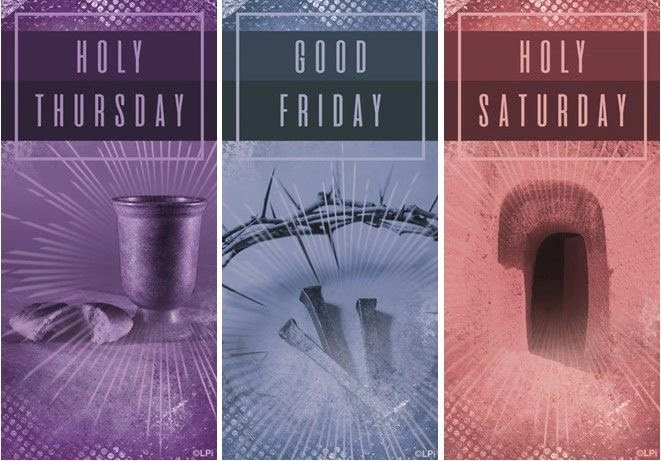
The summit of the Liturgical Year is the Easter Triduum—from the evening of Holy Thursday to the evening of Easter Sunday. Though chronologically three days, they are liturgically one day unfolding for us the unity of Christ’s Paschal Mystery.
The single celebration of the Triduum marks the end of the Lenten season, and leads to the Mass of the Resurrection of the Lord at the Easter Vigil.
The liturgical services that take place during the Triduum are:
- Mass of the Lord’s Supper on Holy Thursday
- Good Friday of the Lord’s Passion
- Mass of the Resurrection of the Lord
HOLY THURSDAY
The evening Mass on Holy Thursday is referred to as The Mass of the Lord’s Supper. This is where the Church re-lives the institution of the Eucharist and the Holy Sacrifice of the Mass at the Last Supper, as well as the institution of the priesthood, which took place the evening before Jesus was crucified.
After the homily there is a “washing of the feet” ceremony, where the priest washes the feet of others to signify his role as servant—just as Jesus did with His disciples. Extra hosts are consecrated at this Mass to be used on Good Friday on which no Mass will be celebrated anywhere.
The Mass of the Lord’s Supper on Holy Thursday concludes with a procession of the Blessed Sacrament to the “altar of repose,” a place where the consecrated Host is kept, away from the main altar where Mass is normally celebrated, remembering Jesus’ request in the Garden of Gethsemane for someone to “watch and pray” with Him.
GOOD FRIDAY
Good Friday is a mandatory day of fasting and abstinence. This is the day of the crucifixion—the day Jesus died for the sins of the world.
The parish altar looks very different on Good Friday: it is plain and bare. There is no consecrated Host in the tabernacle at the main altar of the church; It was carried away on Holy Thursday night to the “altar of repose” to signify Jesus’ death. The candle by the tabernacle is blown out, and the tabernacle doors are left open to show that it is empty. Jesus is gone. This is quite dramatic. It reminds us that Good Friday is a solemn day of mourning and prayer.
The ceremony on Good Friday is not a Mass—it is a Communion Service using the consecrated hosts from Holy Thursday. Good Friday is the only day of the year on which no Masses are offered.
These Good Friday services often take place at 3 PM, the hour that Jesus breathed His last on the cross. Often the priest will begin the service by prostrating himself in front of the altar. Veneration of the Cross usually takes place at this service, in which the priest and the faithful kneel before a cross and kiss it.
HOLY SATURDAY
On this day Christ is in the tomb.
There is no daytime Mass on Holy Saturday. It is still a day of fasting and sorrow before the Easter Vigil begins that evening. We recall, with Mary and the disciples, that Jesus died and was separated from them for the first time as He lay in the tomb. The faithful often continue their Good Friday fast through Holy Saturday.
In the Apostles Creed we pray “He descended into hell” (translated hades, that is, the temporary abode of the dead—not the eternal lake of fire) which describes what Jesus did in the time between his burial and Resurrection. Jesus descended to the realm of the dead on Holy Saturday to save the righteous souls—the Old Testament patriarchs, for example—who died before his crucifixion.
The Catechism of the Catholic Church calls Jesus’ descent into the realm of the dead “the last phase of Jesus’ messianic mission,” during which he “opened heaven’s gates for the just who had gone before him.” Before Holy Saturday, there were no souls enjoying the beatific vision of God in heaven!
A vigil Mass is held after nightfall on Holy Saturday, in celebration of the resurrection of Jesus. This is called the Easter Vigil: the most glorious, beautiful, and dramatic liturgy for the Church.
The vigil is divided into four parts: 1) the Service of Light, 2) the Liturgy of the Word, 3) the Liturgy of Baptism, and 4) the Liturgy of the Eucharist.
This is also the Mass in which many OCIA catechumens are brought into full communion with the Catholic Church.
–GoodCatholic.com
